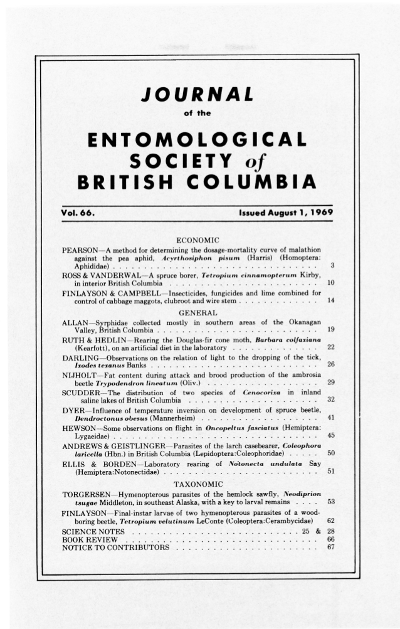Hymenopterous parasites of the hemlock sawfly, <i>Neodiprion tsugae</i> Middleton, in southeast Alaska, with a key to larval remains
Keywords:
parasites, hemlock sawfly, <i>Neodiprion tsugae</i>Abstract
A key is supplied to identify parasitic Hymenoptera reared from hemlock sawfly cocoons in southeast Alaska. The key is based on the size of the exit hole in the host cocoon, and characters visible on the final-instal' larval skin. Brief biologIcal and descriptive notes are given for each species appearing in the key.References
Crosby, D. 1965. Forest insect conditions in the various regions, Alaska, p. 37. In Forest insect conditions in the United States 1964. Forest Service, U.S. Dep. Agr. 41 pp.
Downing, G.L. 1957. The recent history of destructive forest insect activity in Alaska, pp. 111-116. In Science in Alaska 1957, Albert W. Johnson, ed. 8th Alaska Sci. Conf. Proc., Anchorage.
Downing, G.L. 1959. Hemlock sawfly. U.S. Dep. Agr., Forest Serv., Forest Pest Leaflet 31. 4 pp.
Finlayson, T. 1960a. Taxonomy of cocoons and puparia, and their contents, of Canadian parasites of Neodiprion sertifer (Geoff.) (Hymenoptera: Diprionidae). Can. Entomol. 92:20-47.
Finlayson, T. 1960b. Taxonomy of cocoons and puparia, and their contents, of Canadian parasites of Diprion hercyniae (Htg.) (Hymenoptera: Diprionidae). Can. Entomol. 92:922-941.
Furniss, R.L. and P.B. Dowden, 1941. Western hemlock sawfly, Neodiprion tsugae Middleton, and its par.asites in Oregon. J. Econ. Entomol 34:46-52.
Torgersen, T.R. 1968. Parasites of the hemlock sawfly, Neodiprion tsugae, in coastal Alaska. Ann. Entomol. Soc. Amer. 61:1155-1158.
Downloads
Published
Issue
Section
License
Authors who publish with the Journal of the Entomological Society of British Columbia agree to the following terms:
-Authors retain copyright and grant the journal right of first publication with the work simultaneously licensed under a Creative Commons Attribution License that allows others to share the work with an acknowledgement of the work's authorship and initial publication in this journal.
-Authors are able to enter into separate, additional contractual arrangements for the non-exclusive distribution of the journal's published version of the work (e.g., post it to an institutional repository or publish it in a book), with an acknowledgement of its initial publication in this journal.
-Authors are permitted and encouraged to post their work online (e.g., in institutional repositories or on their website) prior to and during the submission process, as it can lead to productive exchanges, as well as earlier and greater citation of published work (See The Effect of Open Access).


